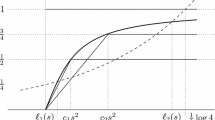Abstract
A decaying 2D homogeneous and isotropic turbulent flow is considered in the self-similar limit, which is achieved with large values of the Reynolds number formed using the time and kinetic energy of the flow if the initial value of the averaged enstrophy tends to infinity with the viscosity tending to zero. In this case, the enstrophy-dissipation rate has a nonzero finite limit. The correlation function of the vorticity field and the enstrophy spectral density in the inertial range of distances and wave numbers, where these functions are free from the effect of viscosity and large-scale flow parameters, is investigated. It turns out that the inertial range exists in the decaying 2D self-similar turbulence in physical space but is absent in the space of wavenumbers. This means that the turbulent vortices of the appropriate size do not contribute to the spectral density, and the well-known law of the first degree is not satisfied. At large wave numbers, the spectral density of enstrophy behaves nonmonotonically—it first decreases faster than the law of the minus first degree and, then, in the dissipation region, it has a growth segment and a second peak. In this case, the enstrophy flow along the spectrum on the left boundary of the dissipation region is only a fraction of the enstrophy-dissipation rate.

Similar content being viewed by others
REFERENCES
G. K. Batchelor, Phys. Fluids Suppl. II 12, 233 (1969).
G. L. Eyink, Nonlinearity 14 (4), 787 (2001).
P. Dmitruk and D. C. Montgomery, Phys. Fluids 17, 035114 (2005).
D. G. Dritschel, C. V. Tran, and R. K. Scott, J. Fluid Mech. 591, 379 (2007).
S. Fox and P. A. Davidson, J. Fluid Mech. 659, 351 (2010).
E. Lindborg and A. Vallgren, Phys. Fluids 22, 091704 (2010).
J. C. McWilliams, J. Fluid Mech. 146, 21 (1984).
R. Benzi, S. Patarnello, and P. Santangelo, J. Phys. A 21 (5), 1221 (1988).
J. R. Chasnov, Phys. Fluids 9, 171 (1998).
A. Bracco, J. C. McWilliams, G. Murante, A. Provenzale, and J. B. Weiss, Phys. Fluids 12 (11), 2931 (2000).
D. G. Dritschel, R. K. Scott, C. Macaskill, G. A. Gottwald, and C. V. Tran, Phys. Rev. Lett. 101, 094501 (2008).
P. A. Davidson, Turbulence in Rotating Stratified and Electrically Conducting Fluids (Cambridge Univ. Press, Cambridge, 2013).
E. Lindborg, J. Fluid Mech. 388, 259 (1999).
R. F. MacKinnon, Math. Comput. 26, 515 (1972).
Author information
Authors and Affiliations
Corresponding author
Additional information
Translated by V. Bukhanov
Rights and permissions
About this article
Cite this article
Vigdorovich, I.I. The Spectrum of Decaying 2D Self-Similar Turbulence. Dokl. Phys. 64, 176–180 (2019). https://doi.org/10.1134/S1028335819040086
Received:
Published:
Issue Date:
DOI: https://doi.org/10.1134/S1028335819040086




